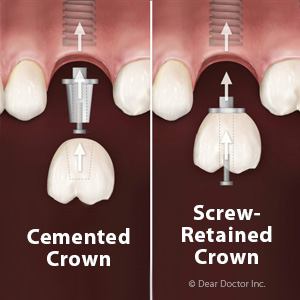If you’ve lost a tooth, you have a number of options for replacing it. Perhaps the best choice in terms of lifelikeness and durability is a dental implant.All implants have the same basic architecture: a titanium metal post imbedded in the jawbone to replace the root; and an abutment, a metal collar that links the post with a lifelike porcelain crown. But implants can vary in how the crown attaches to the abutment and post — either cemented to the abutment or screwed through the abutment to the post.Either method will permanently secure the crown to the implant. But there are advantages and disadvantages for each.A screw-retained crown may better facilitate any future repair that might be needed. For a skilled dentist it’s a simple matter of removing the screw and then the crown from the abutment. There’s less risk of damage to the implant during repairs or crown replacement. Many dentists also prefer screws for crowns placed at the same time they’re installing the implant post (a procedure called immediate loading).The screw access hole, however, could pose a cosmetic problem. Although we can cover it over with tooth-colored filling, it may still be noticeable and unattractive especially for a tooth visible when you smile (in the smile zone). There’s also the possibility the porcelain around the access hole could chip.By contrast, cemented crowns have a smooth, unbroken surface and are aesthetically ideal for smile zone teeth. But the cement could interact poorly with gum and bone tissue in some patients, causing inflammation and possible bone loss.And unlike screw-retained crowns, cemented crowns are difficult to remove for implant repair. We may have to drill through the crown to access the screw between the abutment and the post, and then repair it cosmetically if we use the same crown. Again, the final result may not be quite as visually appealing.In the end, it will depend on the implant’s location, how your body reacts to the cement or your dentist’s preference. In either case, though, you’ll have a tooth replacement that’s functional, life-like and able to endure for many years to come.If you would like more information on dental implants, please contact us or schedule an appointment for a consultation. You can also learn more about this topic by reading the Dear Doctor magazine article “How Crowns Attach to Implants.”
Recent Posts
- The Importance of Emergency Dental Care: Timely Intervention is Key
- Delaying Wisdom Teeth Extraction Can Lead to Serious Issues
- Can an Abscessed Tooth Kill You? Symptoms and When to Seek Urgent Care
- How to Recognize and Effectively Treat a Dental Emergency
- Gum Disease and Heart Disease: Understanding the Connection

